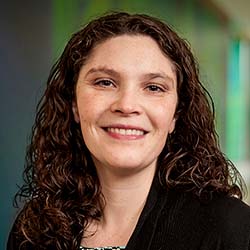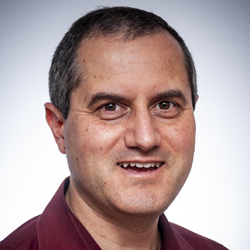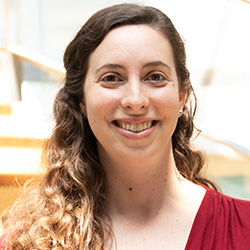Radiation Therapy Service
Contact the Radiation Therapy Service
What is radiation therapy?
Radiation therapy uses high-energy beams and particles to kill cancer cells and reduce the size of tumors. Many tumors are more sensitive to radiation compared to healthy tissue.
- Children often receive a type of radiation called photons. A machine outside the body delivers strong beams of X-rays into the body.
- Proton therapy is like regular X-ray radiation, except that the beams stop once they reach their target.
- Sometimes doctors put a small device inside a child’s body that gives off radiation close to the tumor. The device is temporary. This is used for some types of cancer of the bones and muscles.
- A way to get radiation into cancer cells via the bloodstream is called I-131-MIBG therapy. It is an option for some children with neuroblastoma.
What's special about radiation therapy at Seattle Children's?
We bring together a team of pediatric experts from many fields. We work with you to decide the best treatment plan for your child, including our use of radiation.
-
The experts you need are here
- We have the only radiation oncologists in our region whose main focus is pediatric care. We treat children and teens in Washington, Wyoming, Alaska, Montana and Idaho. A radiation oncologist who is experienced working with children knows best whether — and how — to use radiation therapy for your child. This matters because radiation can harm healthy cells and damage a child’s developing nervous system.
- Each week our doctors from radiation oncology and other specialties, such as chemotherapy, surgery, pathology and radiology, meet at our General Tumor Board, our Brain Tumor Board and our Bone Tumor and Sarcoma Clinic. Other experts such as neurologists, social workers, eye surgeons and child life specialists may also join the meetings.
- The radiation oncologists help the teams decide if radiation may be helpful and what type of radiation to use.
- We talk about each child’s case in great detail. By combining our different skills, we can offer your child the safest and most effective treatment plan. This team approach is called multidisciplinary care.
- Physicists specializing in radiation treatment will make sure the radiation plan is checked and rechecked and that therapy is delivered as intended.
-
A child-focused team
- Nurses trained in both pediatrics and radiation therapy will help care for your child.
- Radiation therapists who have years of training and experience will deliver your child’s treatment under the guidance of our radiation oncologists.
- If your child needs medicine to relax, a pediatric anesthesiologist who is specially trained in children’s sedation will provide it. That way, your child stays still during treatment. We regularly assess whether a child still needs anesthesia. Some children may need anesthesia when they start treatment but later can be treated without it.
- If needed, a child life specialist will help you and your child feel at ease about treatment.
- Experts at our Cancer and Blood Disorders Center take care of your whole child. We don’t just treat their cancer. We care for your child’s medical, physical, nutritional, hormonal, learning, emotional and comfort needs. Read about the supportive care we offer.
-
The most advanced treatments
- Our patients have access to proton therapy through our partnership in the Fred Hutchinson Cancer Center. Fred Hutch Proton Therapy is the only center to offer this type of radiation treatment in the Northwest.
- We are the only hospital in the Pacific Northwest and 1 of only about 20 centers in the country offering I-131-MIBG therapy for children.
- At Seattle Children’s, your child will have access to clinical trials of promising new treatments.
- Our patients benefit from the work of physician-scientists at Fred Hutch and UW Medicine, as well as at Seattle Children’s. The National Cancer Institute has named our partnership a comprehensive cancer center.
-
Care for toddlers through young adults
- We treat more than 100 patients using radiation each year. This means everyone on our team has the experience to make a real difference for your child.
- Our patients range in age from toddlers to young adults. We work hard to reduce any long-term impact to your child from cancer or its treatment.
- We know teens and young adults with cancer have different challenges than children and older adults. Our Adolescent and Young Adult Cancer Program (AYA) focuses on their needs.
- We work to help preserve fertility if treatment might harm your child’s ability to have biological children in the future.
Radiation Therapy Team
Radiation Therapy Service
Radiation Therapy Service options at Seattle Children’s include I-131-MIGB and a precise type of radiation called proton therapy.
Types of Radiation Therapy
Radiation technology has changed a great deal in recent years. Now, doctors can target tumors better and avoid healthy areas or limit damage to them. This means fewer side effects for your child both now and in the future
We offer these types of radiation therapy:
-
Three-dimensional conformal radiotherapy
This method focuses a few X-ray beams on the tumor site. It was the standard for many years and is still useful in many situations.
-
Intensity-modulated radiotherapy
With intensity-modulated radiotherapy (IMRT), doctors use more X-ray beams and focus them in a more precise way. That helps confine the radiation to the tumor.
-
Proton therapy
Unlike X-rays, proton beams stop in the tissue just beyond the tumor target.
With protons, the tumor gets the intended high dose of radiation. The healthy tissue beyond the tumor receives even less radiation than with targeted X-ray beams.
Seattle Children's offers proton therapy at SCCA Proton Therapy. It is the only proton therapy center in the Northwest.
-
Fast neutron radiation
This type of radiation is used for tumors that are not as sensitive to normal (X-ray) radiation. These include some types of tumors affecting the salivary glands or bones. This form of radiation may also be used to treat symptoms of disease.
Our partner, UW Medicine, is the only medical center in North America with a fast neutron treatment system.
-
Gamma knife
This type of radiation therapy focuses the X-rays precisely to treat very small areas. This helps avoid harm to normal tissue. Despite the “knife” in the name, there is no cutting.
It is good for some types of tumors in the head and to treat some problems with the blood vessels.
-
Stereotactic radiosurgery
This treatment is like gamma knife, but is used for tumors in locations outside the head.
It is especially useful for treating some tumors in the lung or spine.
-
Total body irradiation
Seattle Children’s and SCCA are world leaders in stem cell transplants to treat young people with certain cancers. For some patients, X-ray radiation to the whole body is the best way to prepare their body for the new cells.
-
I-131-MIBG therapy
Seattle Children’s doctors are using a new way to get radiation inside your child's body and into cancer cells via the bloodstream. This type of radiation is called I-131-MIBG therapy.
Radioactive iodine is attached to a chemical called MIBG that targets neuroblastoma cells. Your child receives this infusion through a vein. We are the only hospital in the Pacific Northwest to offer I-131-MIBG therapy for children. Only 20 children’s hospitals in the country provide it.
Who needs radiation therapy?
About half of the children and teens we treat for cancer get radiation as part of their treatment. Many also are treated with surgery and chemotherapy.
Some types of tumors respond well to radiation. Others do not. So it is not the right choice for everyone.
We use radiation to treat:
- Bone tumors such as Ewing sarcoma
- Brain tumors
- Soft tissue tumors like rhabdomyosarcoma
- Wilms tumors, a type of kidney tumor
- Neuroblastoma
- Lymphoma
- Some types of leukemia
- Other forms of cancer
- Symptoms caused by tumors (palliative radiation)
Radiation also may be used to prepare children for a stem cell transplant.
Reducing Side Effects
Side effects from radiation therapy vary based on:
- The type of radiation
- Part of the body
- How long your child’s treatment lasts
Your team can help your child manage side effects. Most go away after treatment is finished.
Sometimes radiation causes long-term problems. It can:
- Affect the way a child develops
- Cause infertility
- Cause new and different tumors later in life
- Affect future learning if directed at the brain
- Reduce the growth of bones, muscles and other soft tissues
To prevent those problems, our doctors study ways to:
- Give radiation in smaller doses
- Expose smaller areas to radiation
- Get radiation inside the body in new ways
We work with teens and young adults to help preserve their fertility if treatment might harm their ability to become parents.
- Watch: Cancer Treatments and a Woman's Fertility (13:15)
- Watch: Cancer Treatments and Fertility – Your Options (for males) (10:55)
If your child gets an implanted device or I-131-MIBG therapy, their body fluids (like pee and sweat) will give off radiation for several days. We take special steps to make sure your child gets the care they need while containing the radiation.
Read about these safety steps in I-131-MIBG Treatment: A Guide for Parents and Caregivers (PDF).
What to Expect
If we think your child needs radiation therapy, we will talk with you about the reasons, the benefits and the possible side effects. If you agree that radiation is a good option for your child, we will plan and prepare the best treatment.
-
Treatment locations
- Children receiving photon (X-ray) radiation, total body irradiation, and fast neutron radiation will get their radiation therapy at University of Washington Medical Center (UWMC).
- Gamma knife therapy is done at Harborview Medical Center.
- Proton therapy is offered at SCCA Proton Therapy at Northwest Hospital & Medical Center in north Seattle.
- I-131-MIBG therapy is provided at Seattle Children’s main hospital.
- Children who need an implanted device get care at Seattle Children’s main hospital.
- All of these locations are in Seattle.
-
Before treatment with X-rays or protons
- Your child will have a CT (computed tomography) scan of the tumor site. This tells us the exact location of the tumor.
- Depending on how complex treatment will be, it takes several hours to a couple of weeks to figure out the best angles for treatment and to set up the equipment.
- To make sure everything is set correctly before treatment, your child comes to the treatment room for a “dry run” but does not get any radiation therapy in that first session.
- If your child needs medicine (sedation) to make them relax so they stay still during radiation treatment, the “dry run” and first treatment happen on the same day. Most children younger than age 7 need sedation.
- A pediatric anesthesiologist gives your child the medicine. Once we confirm all settings are correct, and while your child is under sedation, we will give the first dose of radiation.
- The treatment will take place in a large room where the patient is alone but watched continuously with cameras. The team treating your child can talk to your child and your child can talk to them
- Usually, your child can listen to music or stories during treatment.
-
Treatment schedule
For external radiation with X-rays or proton beams:
- Most children come for treatment each day, Monday through Friday, for several weeks.
- Total time at the center is usually 30 to 60 minutes for each treatment.
- If your child needs anesthesia, it will take extra time to help them go to sleep and wake up.
- Most of the time is spent preparing for the treatment and making sure everything is just right.
- The treatment itself takes about 5 to 10 minutes per session.
See details on the schedule for I-131-MIBG therapy for neuroblastoma. If your child needs other internal radiation treatment, your doctor will talk with you about timing.
Contact Us
If you would like an appointment, ask your child’s primary care provider to refer you.
If you have a referral or would like a second opinion, contact the Cancer and Blood Disorders Center at 206-987-2106 or by email.
Providers, see how to refer a patient.
Scheduling an appointment
- How to schedule an appointment at Seattle Children’s.
- If you already have an appointment, learn more about how to prepare.
- Learn about resources such as useful links, videos and recommended reading for you and your family.
Telemedicine at Seattle Children’s
Your child’s first appointment in our clinic will be in person and take about 90 minutes. Later visits may be offered via telehealth (virtual). Learn more about telemedicine at Seattle Children’s.
Paying for Care
Learn about paying for care at Seattle Children’s, including insurance coverage, billing and financial assistance.




